You know when a new Waves plugin drops, it’s a pretty big deal 一 Well, they did it again with the world’s first autonomous EQ: Waves Curves AQ.
It’s all about reading your audio, learning what it actually should sound like, and giving you multiple EQ options that are based on your track’s natural qualities.
Not just some pre-loaded preset.
And today, I’m breaking down everything you need to know about Curves AQ, so we can see if it’s really living up to the hype.
I’ll cover all the unique features/functions you should know about, like:
- AI-powered spectral targeting ✓
- Original EQ profiles (not presets) ✓
- Full static EQ or dynamic EQ flexibility ✓
- Adaptive boost & unique cut controls ✓
- Smart Tilt for total tonal shift ✓
- Offset shifting across the X axis ✓
- 4 personalized frequency anchors ✓
- Contextual EQ with MixSense ✓
- Curves AQ LIVE version for zero latency ✓
- Much more about the Waves Curves AQ review ✓
By the end, you’ll know exactly what Waves Curve AQ is all about and what’s included.
Plus, you’ll know exactly how to use all its features and functions to perfection (from my personal experience).
This way, you can decide for yourself and your team whether it’s worth the hype… or just another plugin collecting dust in your plugin folder.
Table of Contents
- What Is Waves Curves AQ All About?
- Key Features & Functions of Waves Curves AQ
- Spectral Targeting & Autonomous EQ Processing
- Adaptive EQ That Responds to Your Material
- Global & Per-Band Boost/Cut Adjustments
- Reimagined Tone Shaping Tools
- Smart Tilt for Powerful Tonal Balance
- Offset Function for Creative Focus Shifts
- Frequency Anchors for Precise Targeting
- MixSense: Mixing with Most Cases in Mind
- Bonus: Waves Curves AQ LIVE
- Final Thoughts
What Is Waves Curves AQ All About?

So let’s start with the basics: Waves Curves AQ is a brand-new plugin designed to reshape how we think about EQ altogether.
It’s being labeled as the world’s first autonomous EQ, and for good reason, because you’re not just tweaking bands manually anymore…
AQ learns your source (whether it’s vocals, drums, or an entire mix) and decides exactly what kind of tonal shape it thinks would sound best.
Then, it generates 5 completely original target curves based on the natural qualities of your track and from there, the rest is up to you.
You can choose your favorite curve, tweak the behavior with smart controls, and dial it in until it sounds just right.
Don’t worry if this sounds a little vague, I’m going to be breaking down each and every feature/function in the following sections in detail.
Key Features & Functions of Waves Curves AQ
Now let’s get into what really makes Curves AQ stand out and take a look under the hood. So, here’s a breakdown of all its key features and functions so you can see exactly what it’s capable of.
-
Spectral Targeting & Autonomous EQ Processing
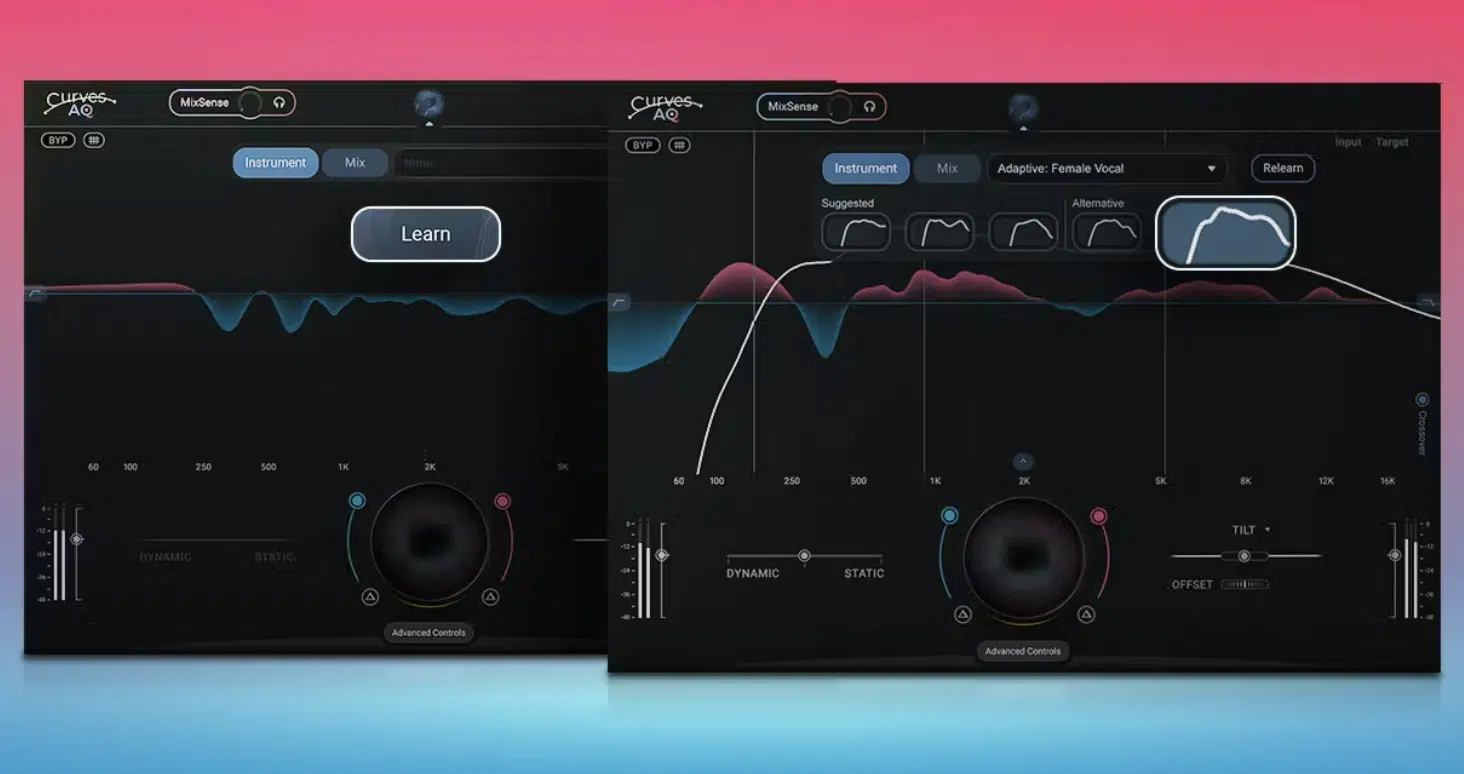
Spectral targeting and autonomous EQ processing is the heart and soul of Waves Curves AQ, hands down.
Instead of acting like a traditional EQ, it starts by analyzing your audio and generating five unique spectral targets built around the natural qualities of your track.
These aren’t generic presets either because each curve is created from scratch based on what the plugin actually hears in your vocals, instruments, or even full mixes.
Once it finishes learning, you’re presented with a visual white curve, and that’s your spectral target, and your sound is automatically reshaped to meet it.
Let’s say you’re EQing a dry vocal that feels boxy in the 400–600 Hz range and needs more clarity in the 8–10kHz pocket…
Instead of having to manually hunt those zones, Curves AQ simply generates a curve that subtly dips the low-mids and lifts the high shelf (super easy, right?).
All while keeping the fundamental locked right where it needs to be, no less.
And you’re not boosting or cutting right away 一 you’re simply tweaking the target, and Curves AQ handles the rest.
What’s extra cool is how flexible the curves feel.
You can switch between all five generated profiles, tilt them, offset them, or scale them based on how aggressive or soft you want the effect to be.
I’ve seen target curves completely transform a harsh hi-hat into something silky, just by selecting a different profile and nudging the main process amount down to 65%.
The autonomous EQ engine behind it doesn’t just react to peaks because it looks at the big picture, which helps smooth out tonal issues without losing the original vibe.
When it’s working, you’ll see blue cuts and red boosts animated across the GUI, showing you exactly how your sound is being reshaped in real time.
It’s a completely different way of approaching EQ and is more like guiding the destination than manually carving every step along the way.
-
Adaptive EQ That Responds to Your Material

What makes Curves AQ feel like a different beast altogether is its dynamic EQ behavior so you’re not stuck with a rigid curve.
Once it learns your source, it continuously responds to:
- Volume shifts
- Transient movement
- Energy across the frequency spectrum
Then, it simply reshapes the EQ to match so you can keep the natural qualities of your audio intact, even during louder or quieter moments.
Take an 808, for example…
On some hits, the sub might be overwhelming; on others, it might dip slightly.
Well, with adaptive processing turned on, Curves AQ automatically evens out those inconsistencies, taming overly resonant moments while preserving punch.
I usually run it with 70% dynamic and 30% static for drums, especially when I want control without killing character, just saying.
It also works great on lead instruments that drift in tone, like a pitch-modulated synth or live bass and stuff like that.
It keeps the main shape focused but reacts just enough to handle tonal variation.
It’s a great middle ground between locking in a clean curve and letting the EQ breathe with your audio, which is honestly what I wish more plugins other than Waves Curves AQ would do by default.
.
-
Global & Per-Band Boost/Cut Adjustments
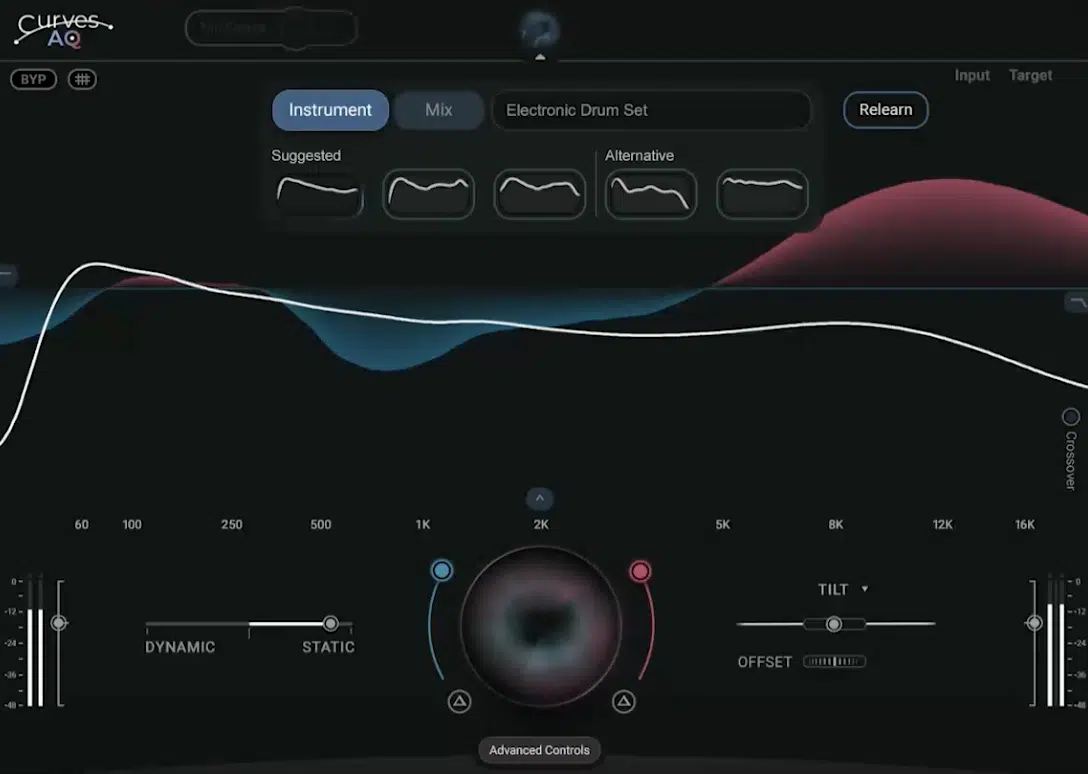
Global and per-band boosts and cut adjustments are where you can really dial in how hard Waves Curves AQ goes in my experience.
You’ve got two main sliders to adjust the overall boosting and cutting amounts globally, and you can also go deeper and fine-tune each frequency band individually.
This matters when you want surgical control without throwing off the overall balance.
For example, if you like the general shape of the EQ but want to ease off the low-end boosts, you can pull that section back to around 50% while keeping the rest of the profile on point/intact.
I did exactly that on a stereo acoustic guitar bus, actually…
The global curve sounded good, but the low-end push was too much for the mix, so I scaled back just that band without touching the highs.
There’s also a clear readout showing exactly how much each band is being altered in decibels.
On a vocal chain, you can keep cuts under -3dB in the mids but allow high-end boosts to go up to +4dB (that’s where I usually find a good combination of clarity and control).
This kind of per-band flexibility gives you guess what? 一 The ability to personalize how aggressive Curves AQ gets, without needing to rebuild the curve from scratch.
And, side note, it’s especially useful when you’re dealing with sensitive tracks like layered harmonies or master bus shaping.
-
Reimagined Tone Shaping Tools

As I mentioned before, Waves Curves AQ isn’t just bringing traditional EQ knobs to the table 一 it brings a whole new set of controls that feel creative, not clinical.
Instead of wrestling with Q widths and dB amounts for hours, you can reshape entire tonal directions with just a few intuitive moves.
This way, you’ve got the ability to:
- Shift the tonal balance
- Refocus the curve
- Scale how intense each move is
All with controls that feel like they were built for actual music production, not just textbook mixing, so that’s super cool as well.
You can, for example, use it on a stacked synth group where each layer has competing high-end content.
Instead of surgically EQing each stem, you can use the broader tone tools to pull everything into place so you’ll achieve a tight sound without losing the vibe.
These tools/gear aren’t about being fancy; they’re about making tonal decisions faster, easier, and more musical overall.
-
Smart Tilt for Powerful Tonal Balance
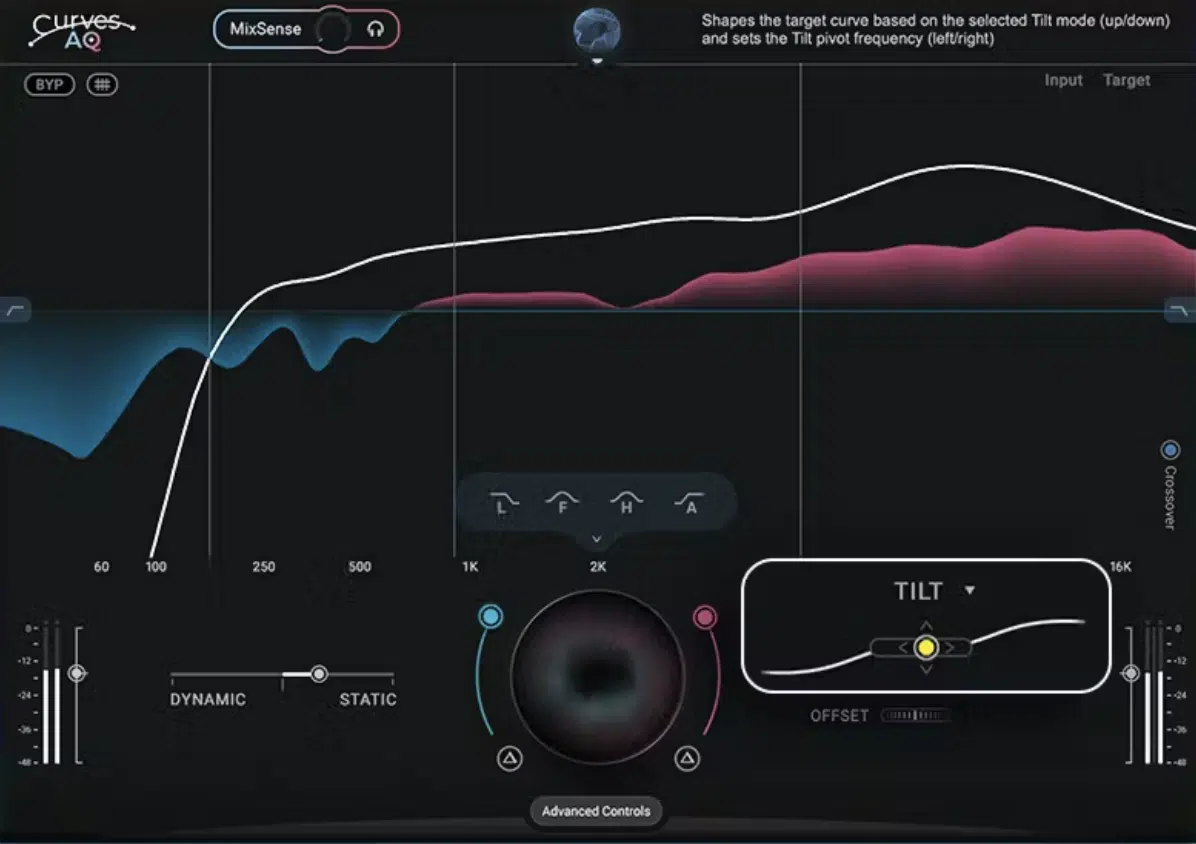
Now, this Tilt function is not your basic shelf boost.
Curves AQ gives you a Smart Tilt control that reshapes the entire spectral target, so the processing that follows has a new tonal goal.
And because you’re tilting the target itself (not the processing directly) the change feels more like adjusting the intention of the sound, not just the frequencies.
This can be subtle or dramatic, depending on how far you push it, of course.
Let’s say your track feels too bright and you want it to lean warmer…
Rather than manually pulling down highs and nudging up lows, just tilt it left and Curves AQ adapts the whole curve automatically (yes, it’s that easy).
For example:
- A -1.5 dB tilt adjustment can gently tuck the top end while giving the low mids more presence
- A full -4 dB tilt can make a snappy, overly digital synth feel way more analog and grounded.
You’re literally telling it, “Let’s go darker,” and it does the rest 一 with one quick tilt down mark it will blend perfectly without losing any clarity.
What’s great is that the effect scales across the spectrum in a way that always feels musical so nothing ever sounds lopsided or over-processed.
This control is perfect for big-picture tonal shaping, especially during the early mixing stages when you’re still figuring out the vibe.
-
Offset Function for Creative Focus Shifts
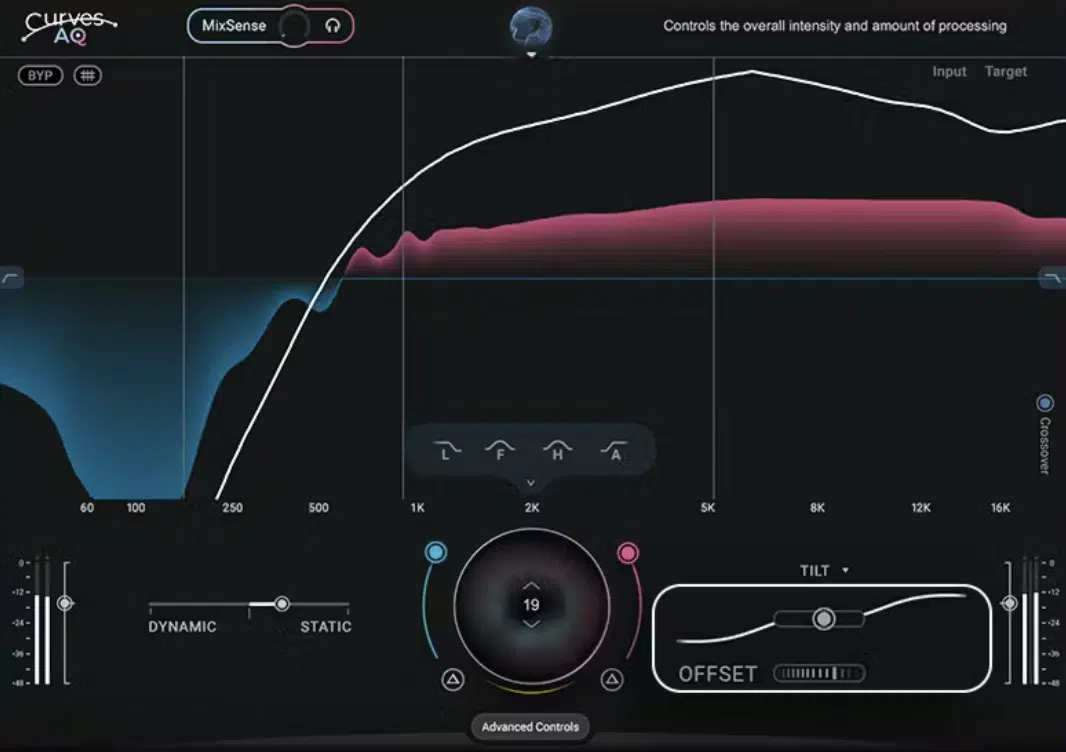
The Offset control in Waves Curves AQ lets you shift the entire spectral target horizontally across the X axis.
It basically changes where the focus of the processing lands without touching the overall curve shape.
It’s like nudging the whole EQ structure to lock in on a different part of your audio’s frequency spectrum.
Let’s say you’ve got a synth that feels too forward around 600 Hz… Instead of boosting or cutting, you can slide the target slightly to the right.
That’ll shift the tonal emphasis higher (maybe closer to 1.2kHz) and the autonomous EQ will refocus the processing in that zone automatically.
I’ve used Offset on reverb returns to subtly brighten the air without harshness — pushing the curve toward 10–12kHz gave me shimmer without messing up the body of the tail.
Even just 3–5% of movement here can dramatically personalize how the track feels (think of it as spectral steering, so to speak).
You’re not changing what shape you’re after, just where that shape lands; it’s super useful when your sound feels close but not quite there.
-
Frequency Anchors for Precise Targeting
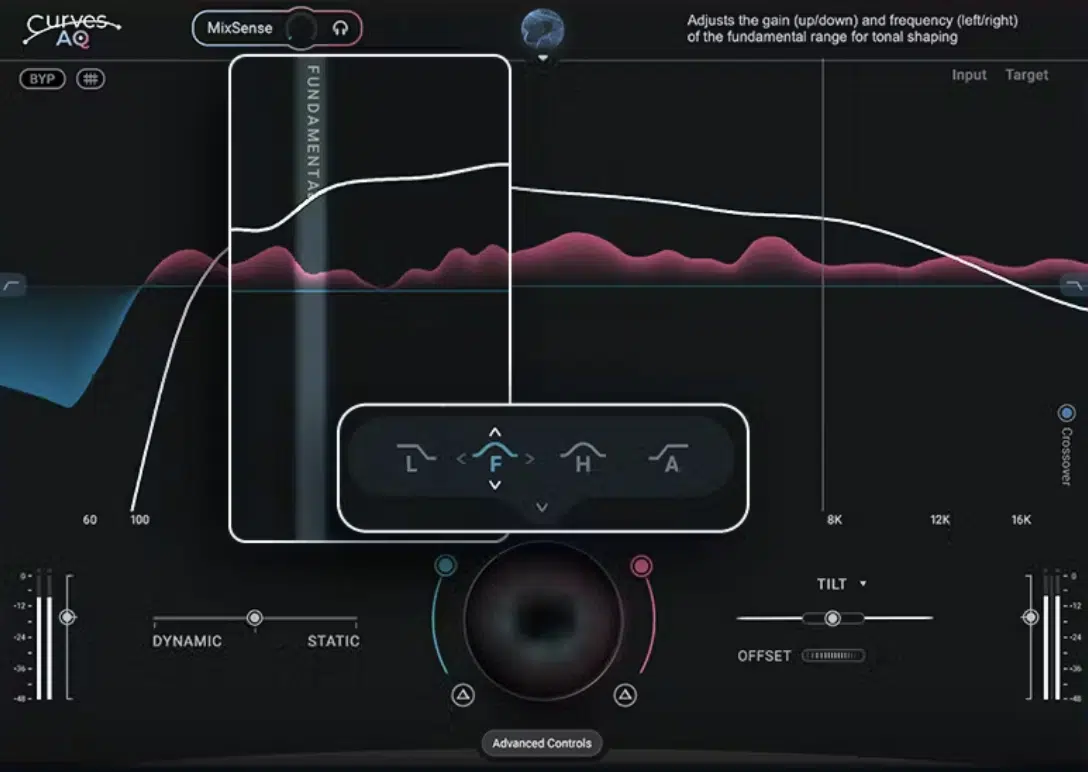
Every time Curves AQ learns a new track, it automatically identifies and locks in four key frequency anchors based on the natural qualities of that source:
- The low end
- Fundamental
- Harmonics
- Air
These aren’t static points; they adapt based on what’s actually going on in your audio.
So if you’re working on a vocal, the low anchor might sit around 150 Hz to preserve warmth, while the air anchor could land near 14kHz to keep that top-end sparkle alive.
On an 808, that same air point might get pushed lower to emphasize saturation or upper harmonics instead.
You can even tweak each anchor’s influence with just a few clicks.
This gives you the power to personalize how much weight or clarity you’re giving to each part of the frequency spectrum.
In one session, I pulled the harmonic anchor forward on a string section to get more bite without touching the highs and it worked like magic.
This feature feels like having four custom EQ macros built specifically for your sound 一 and for fast mix sessions, that level of targeting saves serious time.
-
MixSense: Mixing with Most Cases in Mind
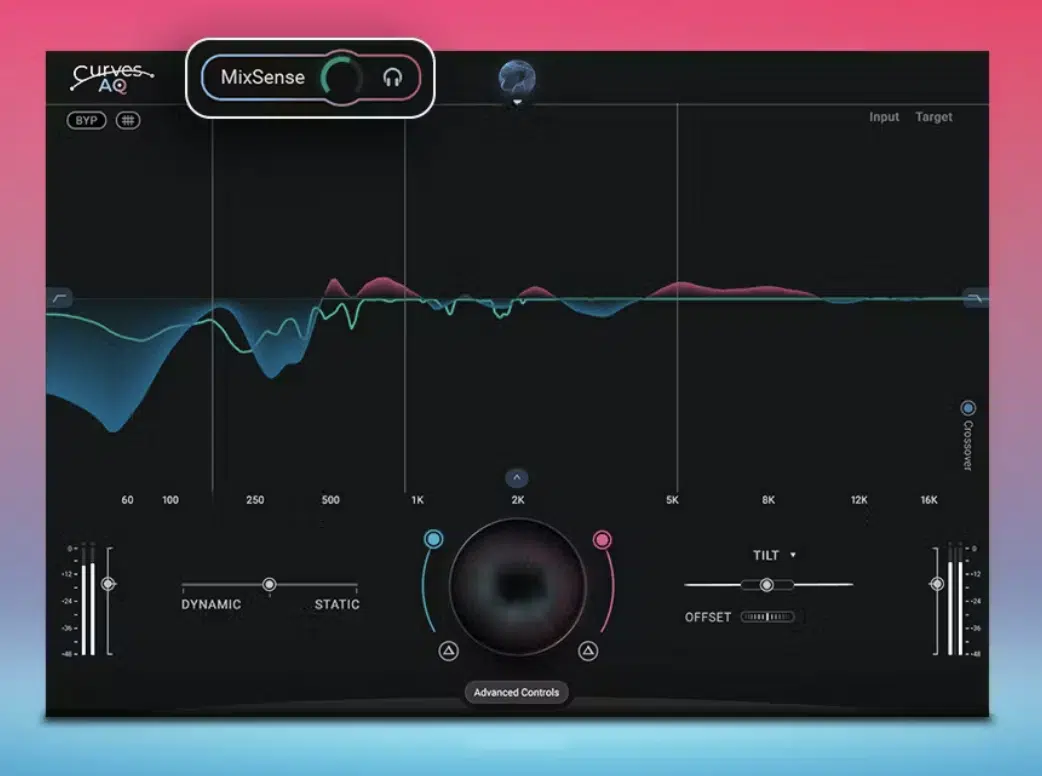
One of the smartest features of Waves Curves AQ is called MixSense, which completely changes how you approach EQ when your tracks are playing together, not in solo.
Instead of blindly shaping a sound in isolation and hoping it fits, MixSense lets you feed in a sidechain source.
Then, it dynamically adjusts your EQ decisions to make room for that input.
For example, if your lead vocal is clashing with a lush pad around 2.5kHz, you can route the pad into MixSense, and it’ll decide exactly how to duck the vocal in that range while keeping its overall tone intact.
You’re not scooping blindly 一 you’re letting Curves AQ work with context, and it adapts in real-time so it’s super easy and on point.
You can use it on, let’s say, a busier mix where guitars and synths were crowding a snare.
And with just a quick sidechain into MixSense, the EQ pulled back the midrange in the synth just enough for the snare to cut through.
You still have full control, but the process feels way more human than the usual EQ dance we do inside crowded sessions.
NOTE: In rooms with less-than-perfect acoustics, or projects where you’re tight on time, this kind of intelligent contextual balancing feels like a cheat code, especially when you’re not working on a full console setup.
-
Bonus: Waves Curves AQ LIVE
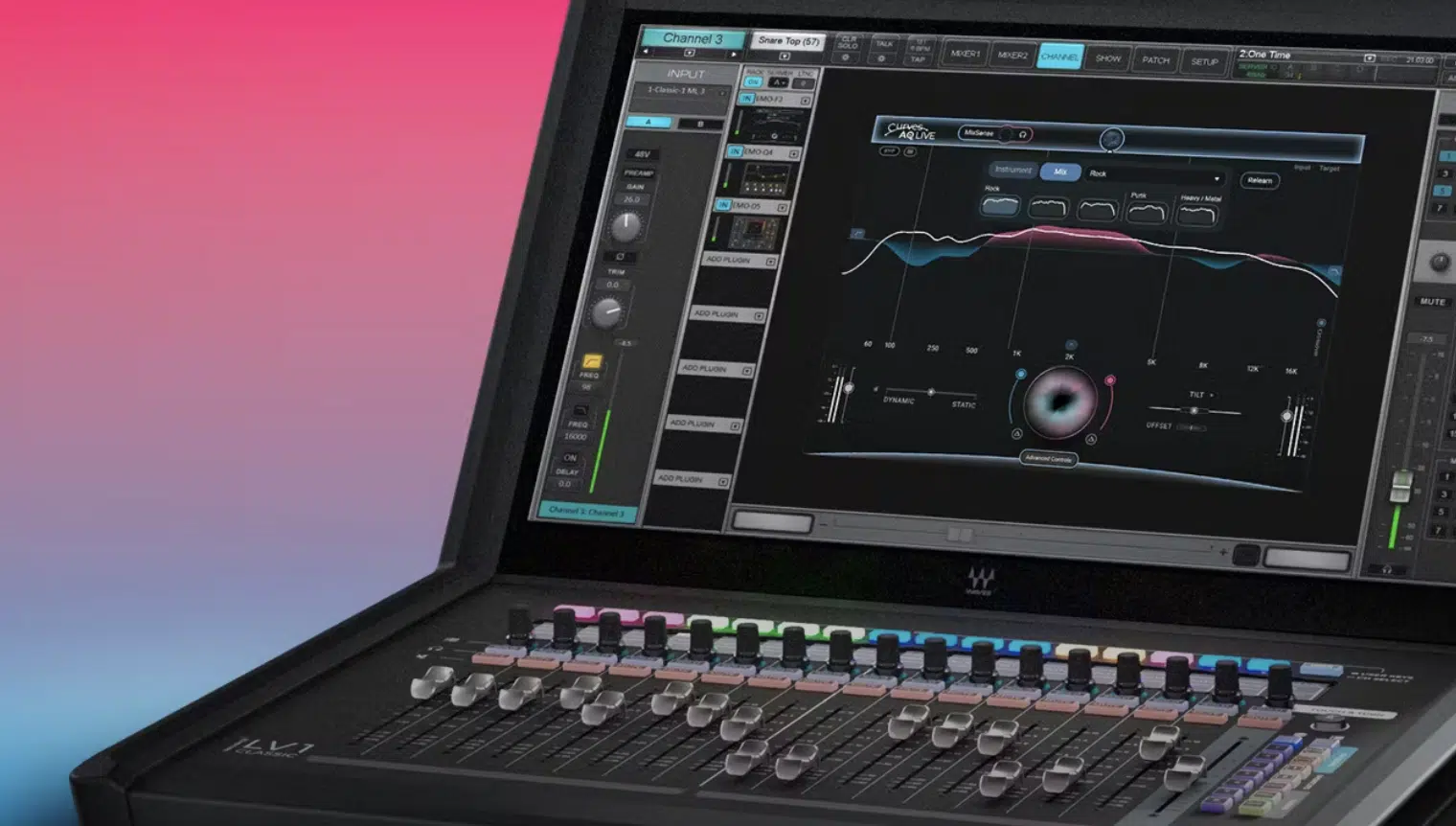
If you’ve ever needed to run EQ live, like a stage performance, broadcast, or just a zero-latency tracking chain, then Curves AQ LIVE is something you’ll love.
It’s a stripped-down, ultra-efficient version of the main plugin that gives you the same autonomous EQ power, just without the added latency that usually comes with heavy analysis.
I ran this in a live vocal chain for a rehearsal session, and it was dialed in within seconds 一 no feedback, no lag, just clean, dynamically shaped tone.
I kept the dynamic EQ mode active and let it adapt to the singer’s tone as they got louder, pushing upper mids around 4kHz just slightly with a combination of subtle boosts and smart attenuation.
Even with limited gear, having something like this running in real-time opens up a whole new level of polish.
And for those of you who run front-of-house or stream performances regularly, this is one of those tools that turns art into consistent results.
So, whether you’re locked into a small room, performing live, or just want zero-latency monitoring with intelligent shaping, Curves AQ LIVE feels like the final touch that makes this the world’s most well-rounded EQ plugin.
If you’ve been on the fence, check the comments because engineers are already calling it one of the most forward-thinking tools of the year.
This thing isn’t just smart. It’s locked in and ready for music production workflows that move fast and expect results.
Final Thoughts
Now you can see for yourself why Waves Curves AQ is already making major waves in the industry.
This epic autonomous EQ really redefines mixing by learning your audio, generating five unique spectral targets, and reacting dynamically to the natural qualities of your tracks.
Whether you’re working with vocals, instruments, or full mixes, it brings unparalleled control and precision to the table.
Its innovative features like Smart Tilt, Offset, and MixSense provide a level of tonal shaping and contextual EQing that traditional plugins simply can’t match.
And, speaking of epic, forward-thinking plugins, you’ve got to check out the #1 AI chord generator: Chord Genie.
This groundbreaking plugin lets you create infinite, pro-level chord progressions with the power of AI 一 eliminating beat block and the need for deep music theory knowledge.
It has a built-in piano roll, key and length selectors, and even drag-and-drop MIDI export, so needless to say, Chord Genie can easily integrate into any unique workflow.
Plus it’s compatible with all major DAWs and VSTs, and it’s designed to be simple, easy, and fun to use, while delivering full customization and professional-quality results.
Whether you’re producing hip-hop, pop, EDM, or any other genre, Chord Genie will help you develop your signature sound and push your music beyond normal limits.
Circling back, Waves Curves AQ is all about intelligent, adaptive EQing that responds to your audio in real-time so your mixes are always balanced and polished.
Now you can take advantage of its advanced features to personalize your sound and achieve professional results with ease.
Just don’t forget to explore the possibilities with Chord Genie as well, because combining these innovative tools can take your production skills to the next level, for real.
Until next time…






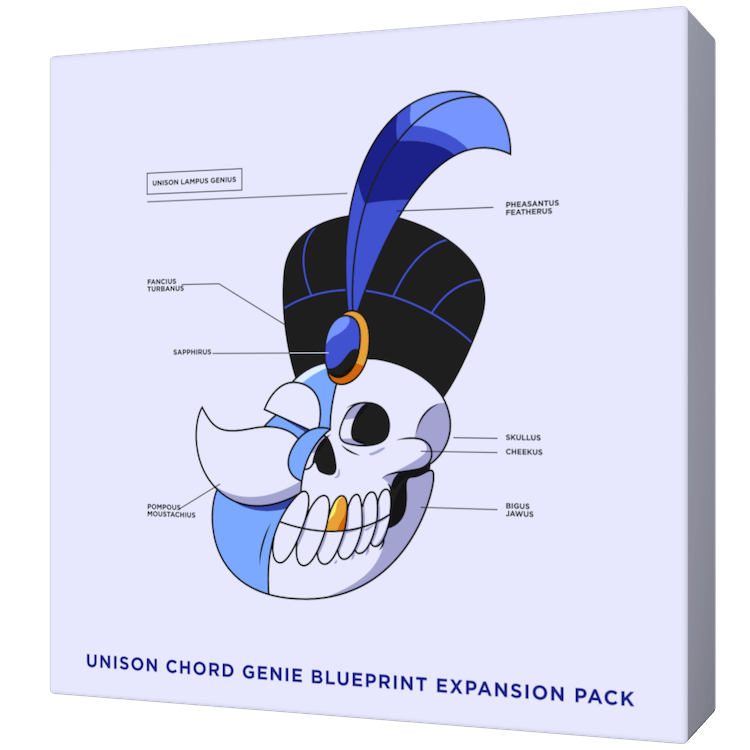
Leave a Reply
You must belogged in to post a comment.